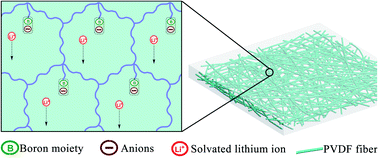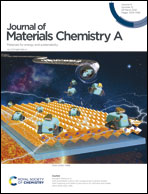Flame-retardant single-ion conducting polymer electrolytes based on anion acceptors for high-safety lithium metal batteries†
Abstract
Solid-state lithium metal batteries (LMBs) assembled with polymer electrolytes (PEs) and lithium metal anodes are promising batteries owing to their enhanced safety and ultrahigh theoretical energy densities. Nevertheless, polymer electrolytes (PEs) suffer from low ionic conductivities, low lithium-ion transference numbers (LITNs) and high flammability. To address these issues, a novel nonflammable single-ion conducting polymer electrolyte (AEP) with ultrahigh ionic conductivity, unity LITN, excellent flame retardance and high flexibility has been developed. Allylboronic acid pinacol ester (AAPE) is incorporated into the 3D cross-linking network of AEP to act as the anion acceptor that traps the anions, improving the LITN to 0.79. AEP possesses an ultrahigh ionic conductivity of 2.52 mS cm−1 at 25 °C. AEP cannot be ignited by flame. AEP can construct robust LiF-rich SEIs on lithium metal anodes and effectively suppress dendrite growth. LiFePO4 cells assembled with AEP demonstrate excellent rate capacity (specific capacity of 112.4 mA h g−1 at 5C rate) and long-term cycling stability (93.2% capacity retention after 500 cycles). This work provides a promising approach to prepare new PEs for high-safety, high-stability and high-energy LMBs.



 Please wait while we load your content...
Please wait while we load your content...